ISSN ONLINE(2278-8875) PRINT (2320-3765)
ISSN ONLINE(2278-8875) PRINT (2320-3765)
| Professor Avishkar Vijay Wanjari Assistant professor, Dept. of EE, Govindrao Wanjari college of Engineering & Technology, Nagpur, Maharashtra, India |
|
Related article at Pubmed, Scholar Google |
Visit for more related articles at International Journal of Advanced Research in Electrical, Electronics and Instrumentation Engineering
The continuity of supply in order to fulfil the demand of consumers is of great concern and has become need of an hour. Transient condition due to various possibilities leads to over voltage. This over voltage on various Electrical elements are of great concern and are meant to be studied in depth in order to reduce the chances of power failure and any other faulty conditions. The focus of this paper is to see the effect of lightning on the railway overhead line with typical using DC overhead line, also the effect of lightning on the various appliances which are used to produce DC supply for the Railway line. In order to design the DC overhead system PSCAD/EMTDC software was used for designing and further investigation was done with the help of the said software. The consequences of transient over voltages caused due to lightning condition and the effective method for eliminating such condition with the help of surge arrester is discussed under this paper.
Keywords |
| DC Overhead system, Over Voltages, PSCAD/EMTDC, Transient |
INTRODUCTION |
| In the year 1752 the great scientist named Benjamin Franklin [1] started to understand the nature of Lightning by simply using the kite and string. He was convinced with a simple experiment that the thunderstorms have a capability to form electricity and the lower side of cloud possesses negative charge [1] at that time. Dangerous, strong and amazing; lightning is the most known naturally occurring phenomenon. The satellites record about 3 million flashes around the world in one day[1]. The lightning phenomenon does not happen only on earth but it also takes place on the neighbouring planet around us. |
| The work discussed in this paper gives the basic idea of the some natural phenomenon occurring around us and its consequences on the electrical components or devices that are being used. Lightning is the most common natural phenomenon; occurring in the nature during thunder storms. The direct strike of lightning on any electrical element, sources, etc., which are open under the clouds may result into the damage of equipment. Therefore, considering its importance in the electrical field it has been selected for the study. |
| It was seen that a lot of work is done on understanding the effects of lightning over voltages on the transmission lines. The somewhat similar work is done by and referred for this project is done by Gharehpetian. G and Shahnia. F, Paul. D (2002), Richter and Brizzi (2005), Mamis and Koksal (2001) etc. For the said authors, the main focus was on Iranian system only. In this paper the DC voltage that is assumed is for country like UK and India. |
| In 2007 at IX International Symposium on Lightning Protection Bernhard Richter [2] presented the use of surge arrester in the DC railway system. The paper published by him giver the idea about the installation point and use of surge arresters in dc fed railways. |
| The same idea about this project was also published in 25th International System Conference, 2010 [3] by some of the researchers in Iran. The paper includes the same concept which is discussed above. With the help of ATP software the researchers have shown the use of lightning arrester in the Light Railway transportation system [3]. The paper shows the results in two cases; including surge arresters located at various points and without surge arresters. As discussed in the paper, lightning strike can affect the railway system very badly and for that reason the importance of arresters. |
| In order to verify the effect of lightning over voltages on an DC overhead line power system simulation software was used for understanding the effects of Lightning. With PSCAD software the above mentioned objectives was achieved and studied. The mentioned software is fast as well as accurate when it comes for the designing of high voltage systems. While designing the system (DC and AC system) for railways a basic idea along with the primary data will be used at a certain extent for achieving the results. |
| In section II, the concept of lightning phenomenon, the necessity of protection from lightning and the views of different authors about the phenomenon is discussed. |
| From section III, the main task of paper with proper circuits and output results is discussed. |
LITERATURE REVIEW |
| Energy has now become the basic need of the human being and now the economic development depends on it. With the failure in the supply energy, many present day appliances used for daily purposes or work may stop. Increase in the population in recent year has also increased the demand of power. So in order to provide that much amount of power the losses has to be minimized. Today transmitting the power with high level of voltages has become more common as it leads to minimum losses with great efficiency. But at these high voltages due to some natural and manual operations the percentage of rise in unwanted voltage level has been increased. This rise in voltage can be called as over voltages which are mainly due to the naturally occurring lightning phenomenon and due to the switching operation when done into the system like opening or closing of circuit breakers, fault etc, and many more. |
| Over voltages caused due to the lightning strikes in the DC electrified railway system affects [4] the equipments included into the system or substation. The over voltages are not only limited up to lightning or switching but there are some other reasons by which transient over voltages can rise into the system and may get transferred into the running trains [4]. The other reasons due to which the over voltage can occur to the DC electrified railway is as follows: - |
| 1. Dc circuit breaker operation which creates over voltage more than 2 times of nominal voltage [4]. |
| 2. Arc formation due to un-even connection of pantograph also results in the formation of over voltages [4]. |
| 3. Operation of vacuum circuit breaker [4]. |
| 4. Loose contacts in the electrical equipments [4]. |
| 5. Current limiting fuses creates arc which may cause the over voltage [4]. |
| In order to minimize the effect caused by lightning, Surge arrester is used in practice. The surge arrester normally has following characteristic which are described below [4]: - |
| 1) Should not operate at the nominal voltage of the system and must have minimum leakage current. |
| 2) Should start operating at the over voltages immediately by letting small increase in its own terminal voltage. |
| 3) Energy stored in DC systems should be able to handle and control. |
| 4) Should bear any atmospheric conditions. |
| 5) Should not fail for the over voltages of the system. |
| As discussed in this paper, the transient over voltages can easily enter the electrical equipment of the traction station. So in order to protect the system more effectively various installation points are important to be considered. The installations points are [4] |
| 1) In the traction substation at primary terminal of transformer and rectifier |
| 2) Ac side of the rectifier unit |
| 3) DC side of the rectifier |
| 4) In between the rectifier output and the input to the overhead line of railway |
| 5) Input point coming from overhead lines to the train |
IMPLEMENTATION OF DC SYSTEM IN PSCAD SOFTWARE |
| For designing this system into the software, the basic idea in order to achieve the DC as the output is considered which can be seen in the block diagram drawn below. |
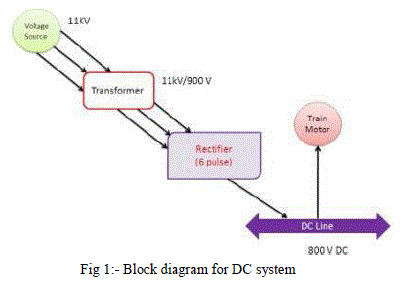 |
| With the same concept discussed above, a new system was designed to see the effect of lightning on the DC overhead line. In this case a DC line is to be considered as connected between two substations. Each substation has different source but same voltage levels, 3 winding transformers at each substation with same ratings and one twelve pulse rectifier at each substation. |
| According to practical point of view, the 12 pulse rectifier which is to be implemented has certain advantages and disadvantages. It has advantages such as it is feasible to reduce the odd order harmonics into the system but again the disadvantage is that economically it is expensive when compared to a single 6 pulse rectifier. It also Increases the size of the system. The improved circuit which is designed in PSCAD software is as shown in the figure below, |
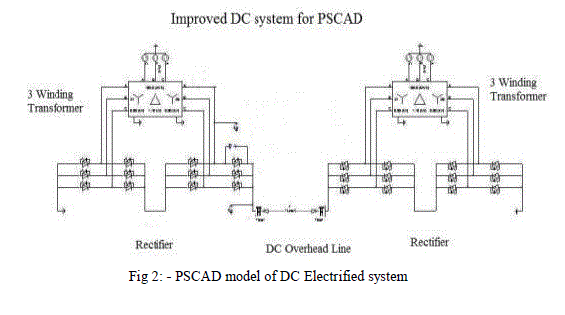 |
DESIGNING OF LIGHTNING STRIFE ON THE AC SIDE OF THE TRACTION SUBSTATION AND IN DC SIDE OF TRACTION SUBSTATION WITH THE IMPROVED DC SYSTEM DESIGNED IN PSCAD |
| In this section the lightning was struck on the AC side of the system and the result was seen on the PSCAD software. The circuit that was used in the above mentioned case is shown in the figure below. In order to produce the lightning surge following data was used, [5] |
 |
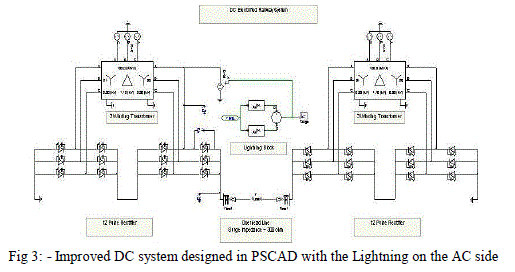 |
| In order to reduce this over voltages due to lightning effect, surge arresters were used at various points. The location of surge arrester here is of very importance, when placed at wrong point may result on non performance of the element. The model in which the surge arresters with various location is as shown in the figure below |
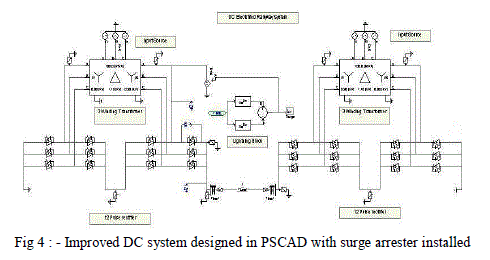 |
| The further analysis of the system is discussed in the next section. Furthermore in next stage the same amount of lightning surge was striked on the DC side of the substation. |
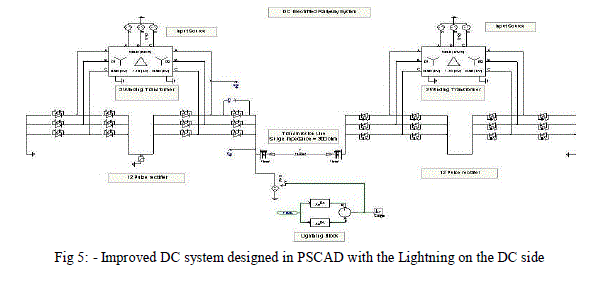 |
SIMULATION AND RESULT |
| Case 1: Effect of lightning when it is struck to the AC side of the traction substation |
| 1] Output of phase voltage when the lightning has struck the AC side of the system and no surge arresters are used for protection. |
| In this case, it was seen that the high peak voltage appears across the phase the moment when the lightning has struck the system. It takes a certain amount of time to settle down the high peak voltage for the phase. The output achieved on PSCAD is shown in the figure below. |
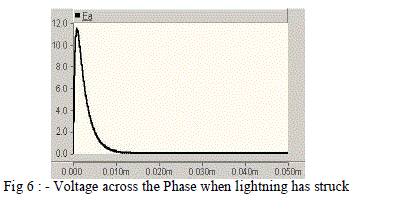 |
| Here from the graph it can be seen that the peak voltage of almost 12 KV is seen across the line when the lightning has struck. |
| 2] Output of voltage across the rectifier unit diode when the lightning has struck the AC side of the system and no surge arresters are used for protection. |
| In this case, for designing the rectifiers diodes were used. When the lightning strikes the AC side the surge from the supply side moves forward to the rectifier. The output for this case is shown in the figure below. |
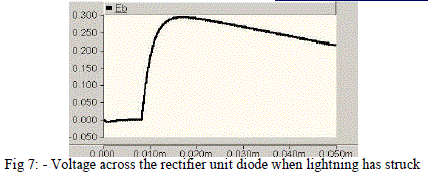 |
| As seen in the circuit, peak appears across the rectifier unit diode which stays for a bit long time. In such situation, the diode sees high voltage continuously which may result into the burning of the rectifier diodes causing failure in the power supply. |
| 3] Output of voltage across the Overhead Line when the lightning has struck the AC side of the system and no surge arresters are used for protection. |
| The lightning surge now from the rectifier travels forward towards the overhead line from which the trains are operated. With high voltage along the line, the components used in the trains like motor, transformer etc detects a sudden change in voltage which finally may burn out the windings of motors or other devices resulting into stopping the train. |
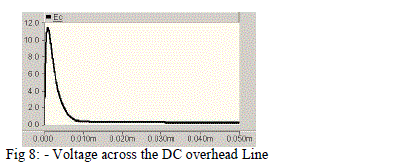 |
| The above graph shows the high peak voltage surge across the DC overhead line when the lightning has struck the system. |
| 4] Output of voltage across the rectifier unit diode when the lightning has struck the AC side of the system and surge arresters are used for protection. |
| Now for protecting the device from over voltages transient, the surge arrester was installed. The surge arrester reduces the high transient voltage that occurs during the lightning. The output for the rectifier diode is shown below which proves that the surge arrester are protecting the diodes. |
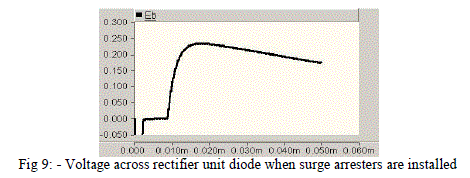 |
| From the graph it can be seen that initially a negative wave is seen, which can be due to the diodes or the difference in the impedance levels. The negative section in above graph can be eliminated if a ground wire is connected to the system. |
| 5] Output of voltage across the Overhead line when the lightning has struck the AC side of the system and surge arresters are used for protection. |
| In this case it can be seen the high voltage that was seen after the lightning strike has been reduced, and thus the components that are used in the train are protected from the over voltage transient from the lightning effect. |
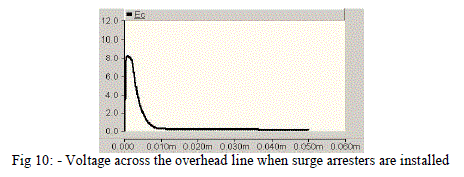 |
| This voltage can also be reduced further if the surge arrester rating is decreased. As it seeks low impedance path the lightning surge flows through it. |
| Case 2: Effect of lightning when it is struck to the DC side of the traction substation |
| 1] Output of voltage across the Overhead line when the lightning has struck the DC side of the system and no surge arresters are used for protection. |
| Now in this case, with same lightning characteristic that is used in section 6.5, is struck near to the overhead line. The high transient surge travels along the line which can be seen in the following graph. |
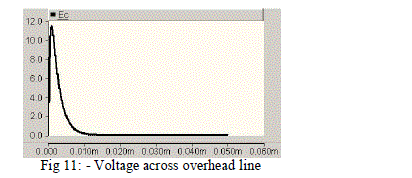 |
| These surge travels along the line which affects the train and the neighbouring sub stations connected for the traction purpose. |
| 2] Output of voltage across the rectifier unit diode when the lightning has struck the DC side of the system and no surge arresters are used for protection. |
| The graph below shows the voltage across the diode rectifier which is transferred from the overhead line to the rectifier. In this case the high peak voltage will not be taken by the rectifier resulting it into the failure in operation. Thus the rectification operation will be stopped from one side of the above system. |
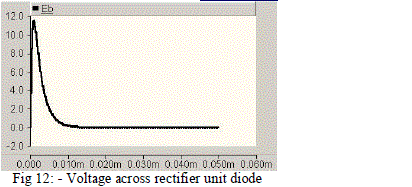 |
| 3] Output voltage near the AC source when the lightning has struck the DC side of the system and no surge arresters are used for protection. |
| In the last part when coming from the DC side, the ac traction is not that much affected though a peek is seen in the above graph but it is under the tolerance level of the transformer. |
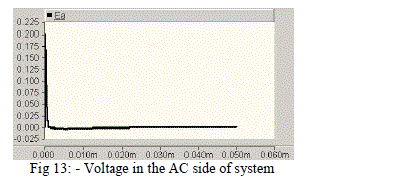 |
| From all the above discussion in various cases it was found that the lightning phenomenon may severely damage the rail system which can be harmful to the passengers travelling in it. So it becomes very essential to protect the system from such over voltages. Also to reduce the economical losses caused due to lightning can be reduced by using the proper protective devices which needs less investment that to only at the time of installation. |
CONCLUSION |
| For this paper, the consequence of lightning over voltage on the railway overhead lines (DC) which are used to supply the trains was investigated and discussed. A typical system arrangement was designed under the PSCAD software for this paper. The most severe problem that affects the supply system of railway was studied. In order to reduce the losses and any critical conditions which may affect the human life directly or indirectly, a suitable protection technique was implemented. It can be concluded that when the lightning hits any of the phases on the AC side of traction station the transient overvoltage flows towards the rectifier along with the induced voltages in the other phases which finally affects the DC overhead line. Also the lightning phenomenon when strikes cause distortion into the supply voltage which creates further harmonics in the rectifier. It can be also said that the line which is hit by lightning increases the flux around it which may create a maximum force between two lines that can be dangerous. With the use of surge arresters in such system proves the efficiency and necessity in reducing the high voltage surges caused due to lightning. Also the location where the surge arresters should be placed is of high importance. |
References |
|